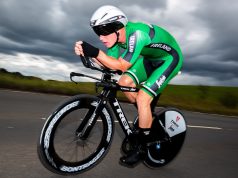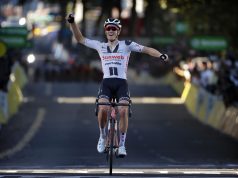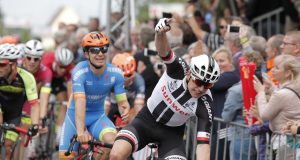With the demands of the cobbled classics unlike any other, the mechanics make many adjustments to the bikes to ensure the riders have as smooth a ride as possible come race day.
Mechanic Alan Williams who sets up all the Pinarellos at the Team Sky service course in Belgium tells some of the secrets of the trade.
1) Handlebars:
One layer of handlebar tape is absolutely fine for regular road racing, but for the cobbled classics such as Paris-Roubaix, we don’t just double the amount of bar tape we use, we also fit gel pads on most of the bars for even greater cushioning. The pads are quite a new innovation that have become increasingly popular over the last few seasons. Most of the padding is placed on the tops of the handlebars, but we can also cut strips of gel to go under the brake levers. Sir Bradley Wiggins, for instance, uses both these options, but it varies from rider to rider.
2) Gear shifters:
As well as having the usual gear shifters on sides of the brake levers, we also give the classics riders the option of having thumb shifters on their drops. These are usually reserved for sprinters who don’t want to change their hand position in the rough and tumble of a sprint, and the run in to the hardest cobbled sections often replicates that. If that wasn’t enough, Bradley also requested a third set of shifters last year on either side of his stem, giving him even more options in the race. We can tailor these set-ups exactly how our riders want them. Each one is totally different and is fully dependant on their individual riding styles. Some riders prefer to tackle the cobbles with their hands on the tops, some on the hoods, and some on the drops. Every handlebar is unique for every cobbled classic.
3) Saddles:
Lightness is often the key when it comes to saddle choice, but at the classics, lots of riders change their saddles to a thicker, more comfortable pad. Elia Viviani for instance, switches his saddle from the regular fi’zi:k Arione model to the thicker Arione K1 version that provides more padding. Again, it all comes down to personal preference, Bradley and Geraint use the K1 for every race they enter.
4) Pedals:
For many years, riders used to change their pedals from carbon to aluminium, but nowadays our riders all stick to the carbon pedals because Shimano make such a robust Dura Ace model. Shimano also provide three options of cleats as well which varies the amount of foot movement (know as float) whilst they are clipped into the pedals.
5) Wheels:
Like the pedals, Shimano produce a really strong Dura Ace C50 wheel which can cope with the demands of even the toughest races, so they’re not any different in the classics to what we normally use. On the off-chance that the wheels do get cracked in action, the fact that the tyres are glued to the wheels means they hold together very well. People often ask if we use wider wheels, but we keep everything the same in that respect and instead change the tyre widths.
6) Tyres:
During the rest of the season we ride on tyres that have a diameter of 25mm, but for Paris-Roubaix we widen that out to 27mm. These gives more suspension, have a slightly different tread, and that results in more grip.
We actually age our tyres for this part of the season. That means we prepare the tyres a few years in advance and then store them in a special room at our service course. We do this as new tyres tend to puncture easier. When you age a tubular wheel, it becomes suppler and doesn’t cut as easily.
One hot topic at the classics is what tyre pressure we use. I can’t discuss that I’m afraid as that’s a closely-guarded secret. Usually we run the tyres at around 8 bar (116psi), but it is lower than that at the classics with us running a wider tyre. We also want the tyre to track the cobbles better. If the pressure was too hard, the bikes would be jolting everywhere. All the riders run different pressures as well depending on their weight.
7) Chainrings:
We run a 44 or 46-tooth front inner chainring during Paris-Roubaix which is the same size as what we generally use during time trials. That’s because Paris-Roubaix is a relatively flat race, and having a larger inner ring means the chain stays tighter, so it’s less likely to come off during the harsh vibrations of the cobbles. The outer ring stays as a 53, but we use a special-designed version that’s built stronger for the classics. We also ensure that every bike is fitted with a chain catcher in every cobbled classic we enter to minimise the risk of riders dropping their chains.
8) Bottle cages:
We use Elite’s aluminium cages as they are more durable than the lighter carbon alternative we normally use. Another innovation we’ve introduced is placing grip tape on the inside of the bottle cages as this increases the amount of friction and help keep the bottles in place.
9) Lubricants and cleaning products:
We don’t use anything different here as the Muc-Off products are all top-notch and can cope with the extra mud and dust build up.
10) Jaguar team car:
During the classics, Jaguar provide use with XF Sportbrakes that have had their ride heights raised, and the suspension softened. The extra height minimises the risk of the cars bottoming out on the uneven road surfaces, and the softened suspension gives a smoother ride. The cars have also had metal plates fitted to their undersides which prevents further damage.
Read more at http://www.teamsky.com/teamsky/home/article/32122#KzkBZx5ZwMjmPbfw.99









